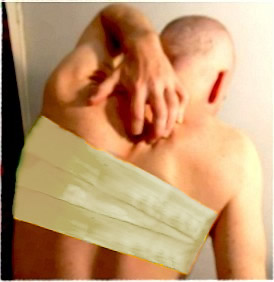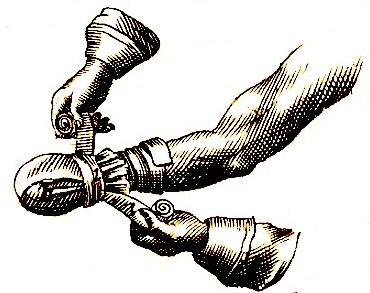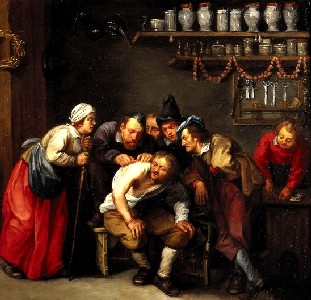
Wound Dressings Page Menu: 1 2 3 4 5 6 7 8 9 10 11 Next>>
Wound Dressings in the Golden Age of Piracy, Page 10
Bandaging Concerns
Period surgeons identified several things that the surgeon should be concerned about when bandaging a patient. We will look at three of them: overly-tight bandaging, itching under the bandages and the best way to remove bandages. These are still relevant today, although it is sort of interesting to see how they were framed at this time in history.
Bandaging Concerns: Overly-Tight Bandaging
Tightness of binding was a concern for period surgeons as we was mentioned in the ways bandaging impacted the humors of the body on Page 9.
To determine if a bandage was too tight, the first thing to do was to ask the patient. Paré suggested inquiring "whether the member seem not to be bound too strait [tight]. For if he [the patient] say that he is unable to endure it so hard

A Sign of an Overly-Tight Bandage
(Actually 'Growths on the Eyes,'
from Opthalmodouleia
by Georg
Bartisch, p. 232 (1583))
bound, then must the binding be somewhat slackned. For, too strait of binding causes pain, heat, defluxion, a gangrene, and lastly, a sphacell or mortification: but too loose is unprofitable, for that it doth not contain the parts in the state we desire."1
Charles Le Clerc agreed that too loose is of little use, noting that if "the Patient complains of nothing, and is very easy, the Dressing is too slack and must be taken off, for however the Patient ought not to suffer much Pain when the Part is bound up, yet he ought to feel some, and not be altogether at his ease."2
Our period surgeons leave this decision entirely to the patient, however. (Patients are notoriously bad judges of such things - some complain too much and others don't complain enough.) They had other ways to detect whether a bandage had been applied too firmly. Le Clerc thought that a bandage was "too streight [tight], when the Veins beyond are exceedingly swoln, and in this Case the Dressings must be taken off and made anew."3
Paré agreed that the sign of overly-taut bandaging was that "the part be hard swoln"4, although he also felt that "an œdematous [fluid-filled] tumor, caused by the blood pressed forth of the broken place"5 was a good sign - it meant the humors were not collecting at the site of the bandaged wound.
Paré goes on to give the remedy for the 'hard swoln' tumor. The bandaging "must presently be loosed, for fear of more grievous symptomes, and the part must be fomented with warme Hydraleum [water and oil mixed together], and another indifferent, yea verily, more loose ligature must be made in stead thereof, as long as the pain and inflammation shall continue; in which time and for which cause, you shall lay nothing upon the part which is anything burdensome. When the patient begins to recover, for three or four dayes space, especially if you find him of a more compact habit and a strong man, the ligature must be kept firm and not loosed. If on the third day, and so untill the seventh, the spires or windings be found more loose, and the part affected more slender; then we must judge it to be for the better. For hence you may gather, that there is an expression and digestion of the humors, causing the tumor made by force of the ligation."6
1 Ambroise Paré, The Workes of That Famous Chirurgeon Ambroise Parey, p. 359; 2 Charles Gabriel Le Clerc, A Description of Bandages and Dressings, p. 5; 2,3 Le Clerc, p. 4; 4 Paré, p. 359; 5 Paré, p. 359; 6 Paré, p. 360
Bandaging Concerns: Itching Under Bandages
"The next taking off and renewing these dressings of this fractured member was occasioned some 16 or 17 days after, by a troublesome itching of the part..." (Richard Wiseman, Of Wounds, Severall Chirurgicall Treatises, p. 427)
Itching is a fact-of-life when it comes to long-term bandaging. As wounds begin to heal, they often itch. However, period surgeons sometimes recognized itchiness as an area of concern when it lasted too long. As Charles G. Le Clerc explains, "If the Patient feel too much Itching under his Dressings, they must be taken off, and the Part bathed with Oxycrate [an astringent mixture of water and vinegar], to allay this troublesome Symptom. However the Surgeon ought not to heed the first Complaints, but must wait to see if he persists, and only wet the Dressings with a little Oxycrate to appease the Itchings without taking them off if it may be."1

In Wiseman's account, quoted at the beginning of this article, he said the itching in that case "was occasioned, I suppose, partly from his liberty in Diet, partly by the heat of the Weather, and want of Transpiration [evaporation of water/sweat]. Upon this account I took off the Dressings, bathed the member with Seawater, and drest him up with emplast. de lithargyro. [a lead-based medicated plaster, which serves as an astringent]."2
Ambroise Paré advanced the humor-based theory of itching, noting that it "ariseth from a collection and suppression of subacride vapours, arising from the blood, and other humors under the skin."3 He felt the humors must be removed, after which "all itching ceaseth. But this cannot easily and freely be evacuated and breathed out, because the pores of the part are shut up, and as it were oppressed with the burden of the emplaisters, boulsters, and ligatures, which are put about the part."4
Paré's solution for this is "to loose the ligatures everie third day, that, as by loosing their tyes, their sanious [serum and pus] and fuliginious [smoky-colored] excrements, shut up under the skinne, may freely passe forth, lest in continuance they should fret and ulcerate it as it happens to most of those who provide not for it by loosing their ligatures. Besides also, the part must bee long fomented with hot water alone, or else with a decoction of sage, chamomile, roses, and melilote [sweet clover] made in wine and water: for long fomenting attenuates and evacuates, but shorter fils and mollifies"5.
1 Charles Gabriel Le Clerc, A Description of Bandages and Dressings, p. 5; 4 Richard Wiseman, Of Wounds, Severall Chirurgicall Treatises, p. 427; 3,4,5 Ambroise Paré, The Apologie and Treatise of Ambroise Paré, p. 171
Bandaging Concerns: Removal of Bandages
"The more Nasty any Business is, the more necessary it is to do every thing neatly". (Charles Gabriel Le Clerc, A Description of Bandages and Dressings, p. 7)

Dressing Removal from A General System of Surgery
by Lorenz Heister, Plate 14 (1750)
Just as it was important to apply a bandage neatly, taking a bandage off was a matter of much discussioin amongst period surgeons. Surgical teacher Pierre Dionis gives a precise account of bandage removal, much of the content of which is as appropriate today as it was when he wrote it:
To unbind the Part, he [the surgeon] must put it in the same Posture it was when bound up; cause the By-stander to hold it firm, and then undoing the Apparatus, and neatly and tenderly taking off the Bands, unrolling them now with one hand, then with the other, without letting them slip out of either; and above all, taking care to avoid giving any Pain: If they stick to one another, or to the Part, to disengage them the more easily, they must be moistened with some Liquor [liquid medicine], which is to be diversified, pursuant to the State of Indisposition. Oil, for Instance, is us'd when the Part is in Pain; Wine, when 'tis cold or weak; and Oxycratum, or Vinegar and Water, when inflam'd.1
Dionis prefaces that comment by noting that "the Dexterity of the Chirurgeon appears by his exact and neat Apposition of the Bands"2 while unrolling them. In fact several surgeons explain that it was a matter of pride as well as professionalism to be able to remove them without offending the patient or the audience. Le Clerc orders the surgeon to "take care not to throw them on, or under the Bed, or on the Floor, for fear you meet with some Affront from the Servants, but rather order a Chair or Plate to lay your Dressings on. Take care to double the Emplaister [as you remove it], that the Bystanders may not see the Pus, which would offend them and make them condemn you as a Sloven."3
Looking at the state of what was on the bandage was important to the surgeon. As mentioned previously, the color of the pus indicated how well the wound was purging those bad humors. So how is the surgeon to remove bandages and still not upset those watching? Le Clerc advises that "when you look upon the Pledgits,

Artist: Adriaen Rombouts
An Audience Enjoys a Plaster Removal (late 17th c.)
which you must not fail to do, that you may judge of the Quality of the Pus and the Condition of the Wound, this must be done with a Cast of an Eye, and dextrously concealed from the Persons by, that it may not give offence to them."4
It is not completely clear why an audience would gather to watch a bandage removal, but since they are referred to by several different medical writers it must have been common enough to comment upon. On a ship the audience would mostly be limited to fellow sailors and perhaps the patient's immediate officers. Being sailors, delicacy was probably not at the top of their list of concerns. On land it would probably have been a different matter - the family may have easily been present. Many surgeons operated in the homes of wealthier patients.
Le Clerc also registers concern over the temperament of the surgeon during bandage removal. He warns that when "taking off or applying the Dressings, the Surgeon must shew a Tenderness, and not say or do any thing which may discover a Cruelty of Temper."5
However, he goes on to explain, "I say you ought to be tender, but not pitiful: For however a Patient may love to be gently dealt with, he had rather be cured; and if a Surgeon discover much Compassion, they apprehend this will hinder him from doing his Duty; or at least will conclude he has not been very conversant in the Business of his Profession."6
Of course, a surgeon taken by pirates may have a different view on matters of civility to the patient. Indeed, we are told that when Captain Edward Low was hit in the jaw, splitting the skin, "the Surgeon was called, who immediately stitched up the Wound, but Low finding fault with the Operation, the Surgeon being tollerably drunk, as it was customary for every Body to be, struck Low such a Blow with his Fist that it broke out all the Stitches, and then bid him sew up his Chops himself and be damned"6. It's a little difficult to imagine such a man being worried about his audience seeing pus.
Fortunately, Le Clerc gives the pirate surgeon some other reasons to be tidy about the work of replacing bandages. He advised the surgeon to have new dressings ready and to be quick about the removal and renewal of the bindings "that
so the Wound may not be left open; and if after it be opened, there shall remain any thing to be done, lay a Rag over it to defend it from the Action of the Air."7 Contact with air is related to the concern about humors. It was

Dressing a Simple Fracture, from Armamentum Chiurgicum
Bipartitum by Johannes Scultetus, Plate 52 (1666)
thought that air could bring external humors into the wound and cause complications.
While we've done away with humoral theory in modern times, studies have been done that show that a bandaged wound will heal faster than one left open to the air.8 Even if humors weren't the cause and a few moments of extra air absorption probably made no difference, there was at least reason to keep a wound bandaged.
Le Clerc mentions another facet of bandaging that has since been proven to be important to helping a wound to heal. He advises cleaning "the Edges of the Wound with the side of your Spatula; for... if you should omit to cleanse it at all, small Ulcers would form themselves under this Crust, which you would not discern."9 When cleaning the wound itself, he explains that "you must not wipe it, but lay a Rag of fine Linnen on it, and press this softly with a little Lint, especially when the Wound begins to look well; for if you should wipe it, you would in a very small time undo what Nature has been a long time finishing."10
Indeed, even soft linen might tear the healing skin if brushed too firmly across it. He further suggest that when "there be Sinuosities [opening in the skin that emit pus], you must syringe it with some convenient warm and spiritous Liquor [liquid], rather than persist to cleanse it with Rags and Tents, which cannot be done without pain."11 While most of the other surgeons do not go into such detail about cleansing wounds, the offhand way in which Le Clerc addresses doing this hints that it must have been a somewhat common practice.
1 Pierre Dionis, A course of chirurgical operations: demonstrated in the royal garden at Paris. 2nd ed., p. 33; 2 Ibid; 3 Charles Gabriel Le Clerc, A Description of Bandages and Dressings, p. 7; 4 Ibid; 5 Le Clerc, p. 12; 6 Captain Charles Johnson, The General History of the Most Notorious Pirates, p. 374; 7 Le Clerc, p. 7-8; 8 "The Claim: Wounds Heal Better When Exposed to Air" by Anahad O'Conner, 8/1/2006, New York Times On-line gathered 4/8/12; 9,10 Le Clerc, p. 7; 11 Le Clerc, p. 8

